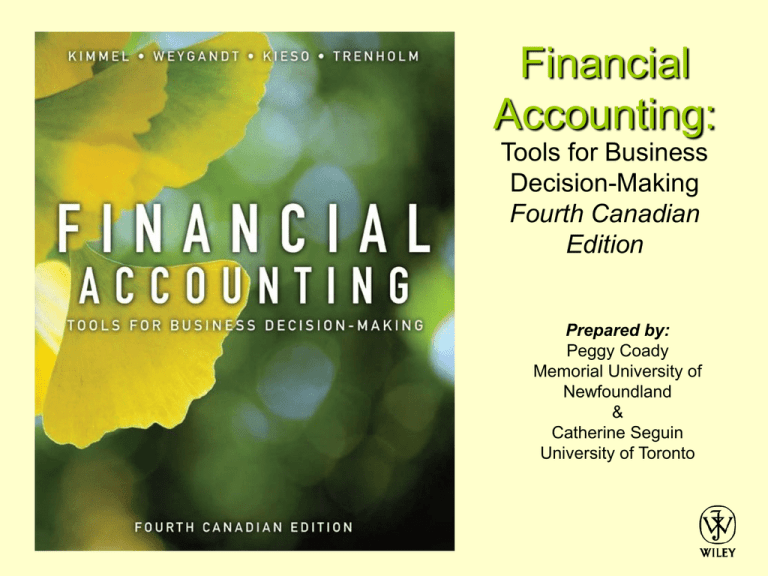
Financial
Accounting:
Tools for Business
Decision-Making
Fourth Canadian
Edition
Prepared by:
Peggy Coady
Memorial University of
Newfoundland
&
Catherine Seguin
University of Toronto
Chapter 2
Financial Statements –
Framework, Presentation
and Usage
Conceptual Framework
of Accounting
• Guides choices about
– what to present in financial
statements
– decisions about alternative ways
of reporting economic events
– the selection of appropriate ways
of communicating such
information
Chapter 2
3
Conceptual Framework
of Accounting
• Four main sections
– Objective of financial reporting
– Qualitative characteristics of
accounting information
– Elements of financial statements
– Recognition and measurement
criteria
Chapter 2
4
Objective of Financial
Reporting
• To provide information that is
useful to individuals who are
making investment and credit
decisions
Chapter 2
5
Qualitative
Characteristics
• To be useful for decisionmaking, information should
have these qualitative
characteristics
– Relevance
– Faithful representation
– Comparability
– Understandability
Chapter 2
6
Qualitative Characteristics
of Accounting Information
• Relevance
– Information is relevant if it makes
a difference in a decision. It is
said to have predictive value,
feedback value, and timeliness
• Faithful representation
– Information should reflect
economic reality. It must be
verifiable, neutral, and complete
Chapter 2
7
Qualitative Characteristics
of Accounting Information
• Comparability
– Accounting information can be
compared when companies with
similar circumstances use the
same accounting standards
consistently from year to year
• Understandability
– Average user is assumed to
understand the accounting
information
Chapter 2
8
Discussion Question
Why is a conceptual framework of
accounting important?
Chapter 2
9
Elements of Financial
Statements
•
•
•
•
•
Assets
Liabilities
Equity
Revenues
Expenses
Chapter 2
10
Recognition and
Measurement Criteria
• Accountants need detailed
criteria to help them decide
when and where an item is
included in the financial
statements.
• Includes
– Assumptions
– Principles
– Constraints
Chapter 2
11
Assumptions
•
•
•
•
Monetary unit
Economic entity
Time period
Going concern
Chapter 2
12
Monetary Unit
Assumption
• Only those things that can be
expressed in terms of money
should be included in the
accounting records
• Important presumption is that
the monetary unit remains
stable over time and the effects
of inflation are nominal
Chapter 2
13
Economic Entity
• Every economic entity can be
separately identified and
accounted for
• Personal items relating to
shareholders are not accounted
for by the business
Chapter 2
14
Time Period Assumption
• The economic life of a business
can be divided into artificial
time periods
Chapter 2
15
Going Concern
Assumption
• The business will continue
operating in the foreseeable
future
• Justifies the use of the cost
principle
Chapter 2
16
Generally Accepted
Accounting Principles
• Cost
• Full disclosure
• Revenue recognition (covered
in Chapter 4)
• Matching (covered in Chapter 4)
Chapter 2
17
Cost Principle
• Assets should be recorded at
cost at the time of acquisition
Chapter 2
18
Discussion Question
Which assumption is an important
underpinning of the cost
principle?
Chapter 2
19
Full Disclosure Principle
• Circumstances and events that
make a difference to financial
statement users should be
disclosed
Chapter 2
20
Constraints in
Accounting
• Materiality
– An item is material if it is likely to
influence the decision of a user
• Cost-benefit
– Ensures that the value of the
information is greater than the
cost of providing it
Chapter 2
21
Classified Balance
Sheet
• A classified balance sheet
generally contains the following
standard classifications:
Assets
Liabilities
- Current assets
- Current liabilities
- Long-term investments
- Long-term liabilities
- Property, plant, and equipment
- Intangible assets
Shareholders’ Equity
- Share capital
- Retained earnings
Chapter 2
22
Current Assets
• Assets expected to be
converted to cash or used in
the business within the year
• Listed in order of liquidity
• Examples include cash, shortterm investments, accounts
receivable, inventories and
prepaid expenses
Chapter 2
23
Long-Term Investments
• Investments in the debt or
equity securities of other
corporations
• These assets are normally not
intended to be sold within the
next year
Chapter 2
24
Property, Plant, and
Equipment
• Tangible assets with relatively
long useful lives
• Assets used in operating the
business
• Examples include land, building,
machinery, delivery equipment,
furniture and fixtures
Chapter 2
25
Intangible Assets
• Noncurrent assets that do not
have physical substance and
represent a privilege or a right
• Examples include goodwill,
patents, copyrights,
trademarks, trade names and
licenses
Chapter 2
26
Depreciation
• Allocation of an asset’s full
purchase price to match cost to
revenues over the entire
estimated useful life instead of
expensing full cost in the year of
purchase
• The cost of long-lived assets
with indefinite lives (e.g., land)
is not depreciated
Chapter 2
27
Depreciation
• Accumulated depreciation
account shows the total amount
of depreciation taken to date
• The difference between the cost
of the asset and its
accumulated depreciation is
referred to as the carrying
amount of the asset
Chapter 2
28
CSU CORPORATION
Balance Sheet
December 31, 2009
Assets
Cash
Accounts receivable
Supplies
Equipment
Less: Accumulated depreciation
Total assets
Chapter 2
$ 2,000
4,000
1,800
$24,000
8,000
16,000
$23,800
29
Liabilities
• Current liabilities
– Obligations that are supposed
to be paid within the coming
year
– Examples include accounts
payable, notes payable, interest
payable, etc.
Chapter 2
30
Liabilities
• Long-term liabilities
– Debts expected to be paid after
one year
– Examples include bonds
payable, mortgage payable,
notes payable, lease liabilities,
etc.
Chapter 2
31
Shareholder’s Equity
• Share capital
– Investment of cash (or other
assets) in the business by the
shareholders in exchange for
preferred or common shares
• Retained earnings
– Earnings kept for use in the
business
Chapter 2
32
Discussion Question
What do you think would be the
main asset, liability, and equity
items for a Tim Hortons
franchise?
Chapter 2
33
Financial Ratio
Classifications
• Profitability ratios
– Measure the earnings or
operating success of a company
for a given period of time
Chapter 2
34
Profitability Ratios
Earnings
per share
Priceearnings
ratio
Chapter 2
Net Earnings Available
to Common
Shareholders
=
Weighted Average
Number of Common
Shares
Market Price per
Share
=
Earnings per Share
35
Financial Ratio
Classifications
• Liquidity ratios
– Measure the short-term ability of
the company to pay its maturing
obligations and to meet
unexpected needs for cash
Chapter 2
36
Liquidity Ratios
Working
capital
=
Current assets –
Current liabilities
Current Assets
Current
ratio
Chapter 2
=
Current Liabilities
37
Financial Ratio
Classifications
• Solvency ratios
– Measure the ability of a company
to survive over a long period of
time
Chapter 2
38
Solvency Ratios
Total Liabilities
Debt to
total
assets
=
Free cash
flow
Net cash provided
(used) by operating
activities – Net
=
capital expenditures
- dividends
Chapter 2
Total Assets
39
Copyright Notice
Copyright © 2009 John Wiley & Sons Canada, Ltd. All rights
reserved. Reproduction or translation of this work beyond that
permitted by Access Copyright (The Canadian Copyright Licensing
Agency) is unlawful. Requests for further information should be
addressed to the Permissions Department, John Wiley & Sons
Canada, Ltd. The purchaser may make back-up copies for his or her
own use only and not for distribution or resale. The author and the
publisher assume no responsibility for errors, omissions, or
damages caused by the use of these programs or from the use of
the information contained herein.





